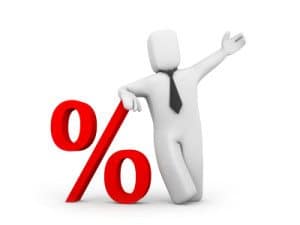Interest vs. APY
The Difference Between APR and APY

Annual Percentage Return is the easiest of the two to understand because its the simple rate of interest that an account or other type of investment earns.
If the account you are looking at quotes an APR of 2%, then you will earn $2 of interest for every $100 invested, per year. Because most of these accounts do not make you wait until the end of the year to get the interest earned during the year however, you have the ability to earn “interest on your interest”. This is where annual percentage yield (APY) comes into play.
Example:
Lets say that you open an account for $100, that pays an annual percentage rate of 10%. This means after 1 year you will have earned $10 as a result of the APR on the account. If this account only paid interest once a year, then the only thing you would need to take into account when evaluating the rate of return with this account, is the APR.
As most accounts pay out interest multiple times a year however, lets take a look at what happens if you get paid your 10% interest at two points throughout the year, 5% after you have held the account for 6 months, and then 5% at the end of the year:
The interest payment of 5% for the first 6 months is the easy part: Take $100 and multiply by 5%, and you can see that you have earned $5 worth of interest for the first 6 months, which brings the total amount now in your account to $105.
The second half of the year is where things get interesting.
You are still getting 5% interest in the second half of the year, but this time that 5% is paid on your new balance of $105, instead of your original balance of $100. This is the concept of compounding, or getting paid interest on interest, and makes it so in the second half of the year you earn 5% X $105 or $5.25 worth of interest.
This also brings the total amount of interest you have earned on your money to $10.25, instead of the $10 you would have gotten if the interest was only paid at the end of the year. While $.25 does not seem like a lot of money, when we start talking about larger dollar amounts, and longer periods of time, this extra interest on interest can make a huge difference.
The additional $.25 paid in the second half of the year is where the difference between the APR and APY comes into play.
In the above example the APR is still 10% but the APY is slightly higher at 10.25/100 = 10.25%, which over time can make a huge difference in earnings.
In the example above, interest is paid semi-annually. To calculate the interest payment, we took the APR and divided it by the number of times that interest was paid per year. If the interest was paid 12 times per year, the interest paid during each period would be 10%/ 12 or 1.2%. Many banks now pay interest daily, 365 times per year, which is better for you. The more frequent the interests compounds, is paid out, the bigger the difference the APR and APY.
Key Concept:
The difference between Annual Percentage Return (APR) and Annual Percentage Yield (APY) is that APY takes into account any compounding that takes place throughout the year, and APR does not.

